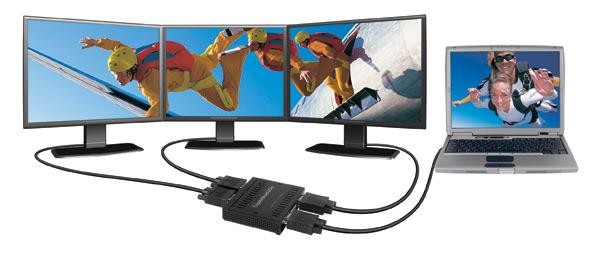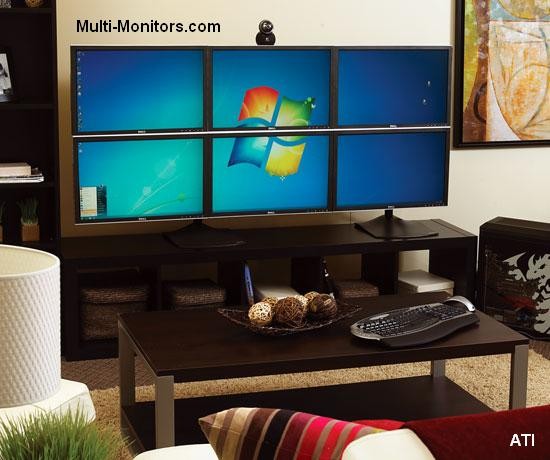Dual or MultiMonitor Laptop for Stock Trading
Post on: 16 Март, 2015 No Comment

Dual or Multi-Monitor Laptop for Stock Trading
Make sure you read How To Choose a Laptop for Stock Trading to find out what the latest laptop features and specifications which are important for trading. Also go to Best Laptops for Stock Trading to get a glimpse of some great laptops for trading, within the various price ranges.
The days of traders confined to their homes or offices are long gone. More and more successful traders and investors take their mobile trading platforms and trading charting software with them to wherever they want to be at a particular period in time. Mobile computer systems have really grown up and now allow you the capability to have multiple monitors connected to your laptop, notebook or netbook. There are a few ways that you can get your laptop to display on multi-monitors as follows:
- using the built-in dual-head VGA Out connector for native dual monitor support,
- an external device connected to the VGA, DVI or DisplayPort adapter like the Matrox DualHead2Go or TripleHead2Go,
- an external device connected to the ExpressCard or PCMCIA slot like DigitalTiger’s SideCar or Appian Traveler,
- an external device connected to the USB 2.0 port
These options are explained below:
Dual-Head Display Laptops

Most laptops currently in the market, like the Lenovo ThinkPad. Sony Vaio. Toshiba Tecra and HP EliteBook series of notebook computers, have multi-monitor support as a standard feature. The video graphics (VGA) cards built into these machines are dual-head versions as they will normally have a VGA Out connector for the second monitor and possibly an additional S-Video output for TVs or external projectors. Laptops can be equipped with discrete graphics from nVidia or ATI or an integrated option like the Mobile Intel(R) 945 Express Chipset. Discrete graphics will give better performance & in some cases improved display quality but cost slightly more.
Extended Multi Monitor Desktops
Microsoft Windows operating systems like Windows 7, Vista and XP, have the capability to extend your the screen of your laptop/notebook/netbook to an external monitor thereby increasing your usable workspace. To activate dual displays for Windows 7, right click on Desktop and select Graphics Properties. If an external monitor is detected, under Operating Mode, there will be an option to choose multi display. For those who prefer Linux, Ubuntu 8.04 (Hardy Heron) and above have built-in multi-monitor capability. Other legacy operating systems like Windows 2000 and Windows 98 are however just restricted to displaying a mirror image of the primary desktop, which is useful for presentation purposes when using an external projector. (** Note that Win2000 & Win98 can however display unique extended screens for desktop systems with dual-head or mutiple VGA cards installed).
Matrox DualHead2Go & TripleHead2Go
Matrox offer the DualHead2Go and TripleHead2Go. which are actually external multi-display upgrades that are not graphics cards, but rather palm-sized boxes that sit outside of your system. DualHead2Go takes the existing single monitor display output (i.e. external VGA output) from your system and expands it into dual display outputs, allowing you to run your Windows desktop at up to 2560 x 1024 resolution stretched across two displays. Using DualHead2Go in conjunction with the built-in display of your laptop, you actually benefit from 3 displays at a time.
Appian Traveler
If your laptop doesn’t have the dual-head VGA card, you can install a 3rd party PC Card (PCMCIA) from Appian called the Appian Traveler which gives your laptop multi-monitor capability. This card supports digital (DVI) output and supports resolutions up to 1280 x 1024. Appian has discontinued this product but you may be able to find some new or used units on eBay.
SideCar Concept
DigitalTigers has a very innovative approach towards offering multi-monitor support for laptops and notebook computers. They have developed an accessory called the SideCar that enables the user to drive up to four extra displays from a WindowsXP/2000 mobile system. The SideCar attaches to the notebook via a simple PC Card interface and when combined with a notebook’s built-in LCD display and external monitor, you can display up to six displays with a single Windows laptop!
External USB 2.0 To VGA Adapter
The quickest way to get additional monitors is to get an external USB 2.0 to VGA/DVI/HDMI device. Some of these devices can support up to 6 external monitors connected to a single USB 2.0 port. These devices can support resolutions from 640×480 up-to SXGA 1400×1050 (or 1280×1024). If image quality is not of paramount importance, this solution provides the quickest and cheapest option to connect more than 2 external monitors.














